|
Those Who Leave and Those Who Arrive (No.51)
02 May 2014
A former Ambassador of Japan to Belgium, my 3rd predecessor, had been staying in Brussels since a few days and returned back to Japan on today’s flight. He finished his mission in Belgium late 2006, but even after his retirement from office, he worked as a board member of a Belgian company and visited Belgium several times a year to attend the board meetings. However, it has been decided that he will quit his job as executive after this last board meeting and he might thus have less opportunity to visit Belgium. As I mentioned in Ambassador’s Chat No. 16, I am the 26th Ambassador of Japan to Belgium and the 20th after World War II. In the case of Japanese diplomats, the term of office is not predetermined. In that sense, it is hard to settle down as it is not known how long one’s term of office will be. Looking back to terms of office of the Ambassadors of Japan to Belgium after World War II (1952 and after), the longest tenure was 5 years and the shortest was 1 year and 8 months, a considerable difference. The simple average length would be then about 3 years. In my case, I have worked in Belgium now for one and a half years, so I might be past the middle of my term of office. I will do my best for what’s left of my tenure as Ambassador of Japan.
< Female President of the Federation of Enterprises in Belgium >
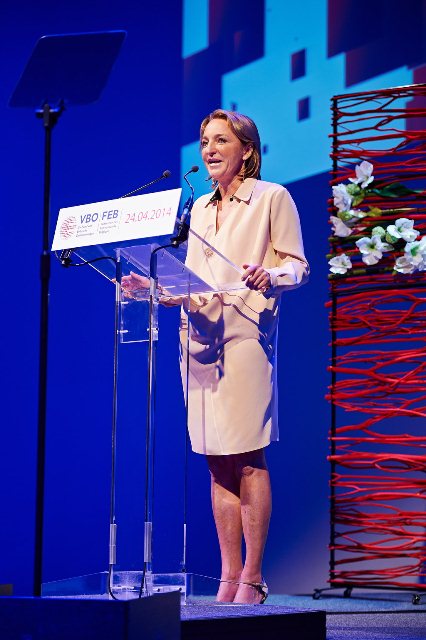 From the automotive sector to the textile industry— One week ago a ceremony of the new president of the Federation of Enterprises in Belgium (FEB-VBO, equivalent of Japan’s Keidanren) was held in Brussels. Pierre Alain de Smedt, who was the former president for three years, stepped down with Ms Michele Sioen becoming the new president. It is the first time in FEB’s history for a female business entrepreneur to become president. It felt as if a generational change took place in the Belgian industrial world as the difference in age between the two is quite large (70 and 48). After having worked at important positions for Renault for a long time, Mr de Smedt then was the president of FEBIAC and in March 2011 assumed the position of president of the FEB. When I arrived in Belgium a year and a half ago, the first businessman I met with was Mr de Smedt, whose kind and sincere personality left a strong impression on me. From the automotive sector to the textile industry— One week ago a ceremony of the new president of the Federation of Enterprises in Belgium (FEB-VBO, equivalent of Japan’s Keidanren) was held in Brussels. Pierre Alain de Smedt, who was the former president for three years, stepped down with Ms Michele Sioen becoming the new president. It is the first time in FEB’s history for a female business entrepreneur to become president. It felt as if a generational change took place in the Belgian industrial world as the difference in age between the two is quite large (70 and 48). After having worked at important positions for Renault for a long time, Mr de Smedt then was the president of FEBIAC and in March 2011 assumed the position of president of the FEB. When I arrived in Belgium a year and a half ago, the first businessman I met with was Mr de Smedt, whose kind and sincere personality left a strong impression on me.
 There are strong ties with Japan in the automotive business so I was heart-warmingly welcomed. Michele Sioen is a young and energetic type and is the president of a specialised textile processing company, Sioen Industries, which her father had established (annual revenue of 323 million euros; close to 4000 employees in 15 countries). In her inaugural greeting which lasted over 20 minutes she emphasised on the necessity of restructuring and innovation of the market if Belgium wants to keep up with globalisation, developments in IT, and the international competitiveness in the global market. She also addressed quite openly which role the politicians should undertake. She further stressed that Belgium has a 16% higher labour cost, and alarmingly high-increasing energy costs compared to its neighbouring countries, and that the development of companies create jobs and increase consumption which leads to flourishing economies. This logic can also be applied on Japan’s current economic state, don’t you think? There are strong ties with Japan in the automotive business so I was heart-warmingly welcomed. Michele Sioen is a young and energetic type and is the president of a specialised textile processing company, Sioen Industries, which her father had established (annual revenue of 323 million euros; close to 4000 employees in 15 countries). In her inaugural greeting which lasted over 20 minutes she emphasised on the necessity of restructuring and innovation of the market if Belgium wants to keep up with globalisation, developments in IT, and the international competitiveness in the global market. She also addressed quite openly which role the politicians should undertake. She further stressed that Belgium has a 16% higher labour cost, and alarmingly high-increasing energy costs compared to its neighbouring countries, and that the development of companies create jobs and increase consumption which leads to flourishing economies. This logic can also be applied on Japan’s current economic state, don’t you think?
< A New Chief Justice at the Court of Cassation >
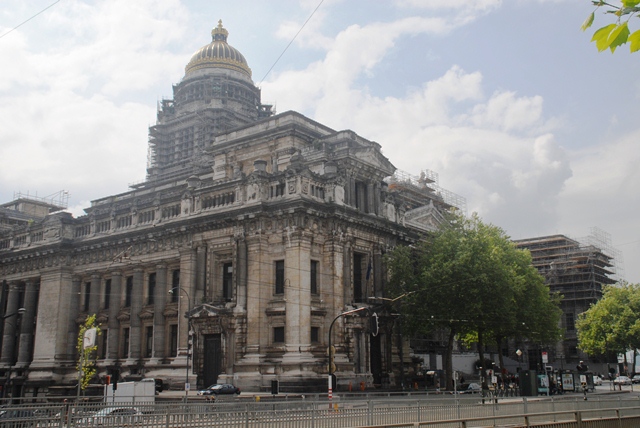 The following day, as a member of the diplomatic corps, I attended the inauguration of the First President of the Court of Cassation, held at the Palace of Justice. Chief Justice Etienne Goethals who now retired had only been at his position for two years, but he was often seen on the reception parties of countries celebrating their national days, and he also attended the Emperor’s Birthday reception which I had organised. His successor is former vice-president Knight Jean de Codt, who will now be tasked with the responsibility to oversee the conduct of justice. As Japan does not have a judicial body such as the Court of Cassation, the Japanese are unfamiliar with it. It is a “supreme court” that concerns itself with the legal proceeding of the judicial system, and has the authority to interpret the validity and application of the law at the various courts. It can also abolish original rulings if decided the rulings were not appropriate. Furthermore it also has the authority to dismiss lower court judges from their position, which corresponds to the function of Japan’s Court of Impeachment. The Court of Cassation was built soon after the independence of Belgium in 1831 and is made up of three chambers with each 16 judges. The following day, as a member of the diplomatic corps, I attended the inauguration of the First President of the Court of Cassation, held at the Palace of Justice. Chief Justice Etienne Goethals who now retired had only been at his position for two years, but he was often seen on the reception parties of countries celebrating their national days, and he also attended the Emperor’s Birthday reception which I had organised. His successor is former vice-president Knight Jean de Codt, who will now be tasked with the responsibility to oversee the conduct of justice. As Japan does not have a judicial body such as the Court of Cassation, the Japanese are unfamiliar with it. It is a “supreme court” that concerns itself with the legal proceeding of the judicial system, and has the authority to interpret the validity and application of the law at the various courts. It can also abolish original rulings if decided the rulings were not appropriate. Furthermore it also has the authority to dismiss lower court judges from their position, which corresponds to the function of Japan’s Court of Impeachment. The Court of Cassation was built soon after the independence of Belgium in 1831 and is made up of three chambers with each 16 judges.
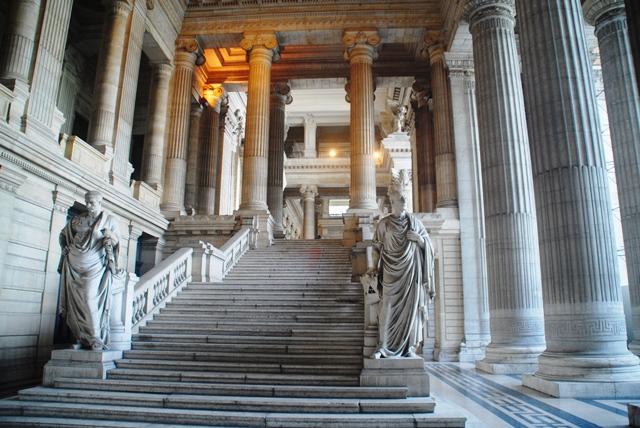 That day it was the first time I had entered the building of the Palace of Justice and I was utterly surprised by its size. The fact that this Palace built at the time of King Leopold II in 1883 has a surface area over 26,000m2 and a centre dome that rises up to 97m high was really something astonishing. The building’s grandness reminds one of even the palaces of ancient Greece and Rome. It is said to be the largest Supreme Court building in Europe. To those who are interested in such large buildings I would definitely recommend to come see it. That day it was the first time I had entered the building of the Palace of Justice and I was utterly surprised by its size. The fact that this Palace built at the time of King Leopold II in 1883 has a surface area over 26,000m2 and a centre dome that rises up to 97m high was really something astonishing. The building’s grandness reminds one of even the palaces of ancient Greece and Rome. It is said to be the largest Supreme Court building in Europe. To those who are interested in such large buildings I would definitely recommend to come see it.
< President Buysse Leaving Bekaert >
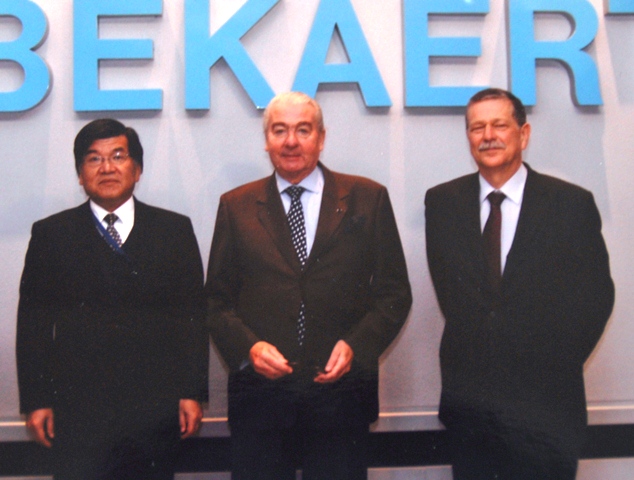 The previous day the retirement ceremony of Paul Buysse, president of famous Belgian steel manufacturer Bekaert, was held at a theatre in the centre of Brussels. Mr Buysse was the first president of the company -- a family-owned business dating back 134 years -- coming from outside of the Bekaert family. He was the president from 2000 onwards for 14 years. He is the face of Belgium’s industry and was recently given the title of Count by King Philip. I have already given an introduction of Bekaert’s establishment in < Barbed Wire Arising from Cattle Disputes > (Chat of the Ambassador No. 9), but nevertheless, now Bekaert is a large company spanning factories in 20 countries around the world and counting 27,000 employees. As his successor CEO Bert de Graeve will take his place. As response to my congratulations to new president Mr de Graeve, I received the following from him: “We have close ties with Japanese companies such as Nippon Steel, and Bridgestone is also a valuable client to us. The relationship with Japan is of importance to Bekaert.” The previous day the retirement ceremony of Paul Buysse, president of famous Belgian steel manufacturer Bekaert, was held at a theatre in the centre of Brussels. Mr Buysse was the first president of the company -- a family-owned business dating back 134 years -- coming from outside of the Bekaert family. He was the president from 2000 onwards for 14 years. He is the face of Belgium’s industry and was recently given the title of Count by King Philip. I have already given an introduction of Bekaert’s establishment in < Barbed Wire Arising from Cattle Disputes > (Chat of the Ambassador No. 9), but nevertheless, now Bekaert is a large company spanning factories in 20 countries around the world and counting 27,000 employees. As his successor CEO Bert de Graeve will take his place. As response to my congratulations to new president Mr de Graeve, I received the following from him: “We have close ties with Japanese companies such as Nippon Steel, and Bridgestone is also a valuable client to us. The relationship with Japan is of importance to Bekaert.”
< A Japanese Ballerina in Antwerp >
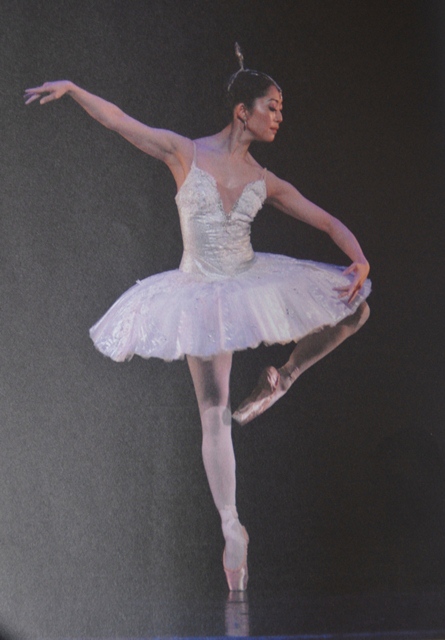 Last month, the Royal Ballet of Flanders gave a special performance at the Opera House in Antwerp. At the event the evening before to which I was invited, I watched Ms Aki Saito dance the leading role. Nearly 10 years ago Ms Saito became the principal dancer in this world-renowned ballet company and is, so to speak, the “signboard” of the company. She was a prize winner at the Prix de Lausanne, an international ballet competition, now also widely known among the Japanese. After becoming a professional dancer, Ms Saito also served as a jury member at that same competition. As a junior high school student, she also had a brilliant career, winning the National Ballet Competition in Japan. That evening, Ms Saito performed one act from “La Bayadère, the Kingdom of the Shades”, in which she danced the protagonist’s role splendidly. In the interviews with Japanese magazines, Ms Saito says that “Ballet is both dance and art. Dancers are artists”. About her own dancing, she says “When I am on stage, the life of the main character swoops down upon me, dwells in my body and I move freely”. Impressive words. Ms Saito’s dancing has ‘heart,’ she makes you feel the inner side of the dancer. By the way, there are 5 ranks of dancers at the Royal Ballet of Flanders. Ms Saito is one of the principals in the highest rank, but both in the Corps de Ballet (5th rank) and in the rank of interns below that, there is one Japanese woman respectively. I would like them to do their best, aiming to follow in Ms Saito’s footsteps. Last month, the Royal Ballet of Flanders gave a special performance at the Opera House in Antwerp. At the event the evening before to which I was invited, I watched Ms Aki Saito dance the leading role. Nearly 10 years ago Ms Saito became the principal dancer in this world-renowned ballet company and is, so to speak, the “signboard” of the company. She was a prize winner at the Prix de Lausanne, an international ballet competition, now also widely known among the Japanese. After becoming a professional dancer, Ms Saito also served as a jury member at that same competition. As a junior high school student, she also had a brilliant career, winning the National Ballet Competition in Japan. That evening, Ms Saito performed one act from “La Bayadère, the Kingdom of the Shades”, in which she danced the protagonist’s role splendidly. In the interviews with Japanese magazines, Ms Saito says that “Ballet is both dance and art. Dancers are artists”. About her own dancing, she says “When I am on stage, the life of the main character swoops down upon me, dwells in my body and I move freely”. Impressive words. Ms Saito’s dancing has ‘heart,’ she makes you feel the inner side of the dancer. By the way, there are 5 ranks of dancers at the Royal Ballet of Flanders. Ms Saito is one of the principals in the highest rank, but both in the Corps de Ballet (5th rank) and in the rank of interns below that, there is one Japanese woman respectively. I would like them to do their best, aiming to follow in Ms Saito’s footsteps.
< The Botanical Garden of Kalmthout and Siebold >
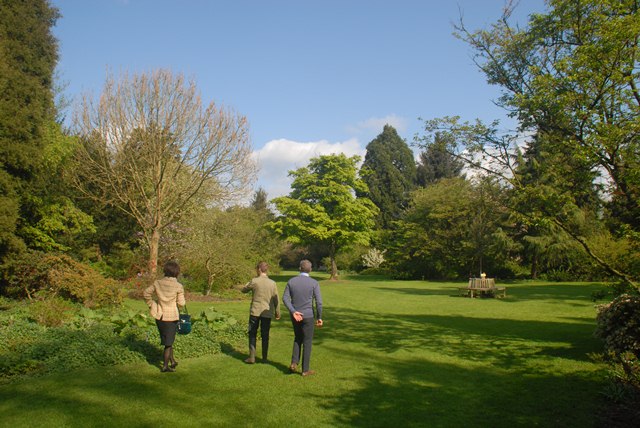 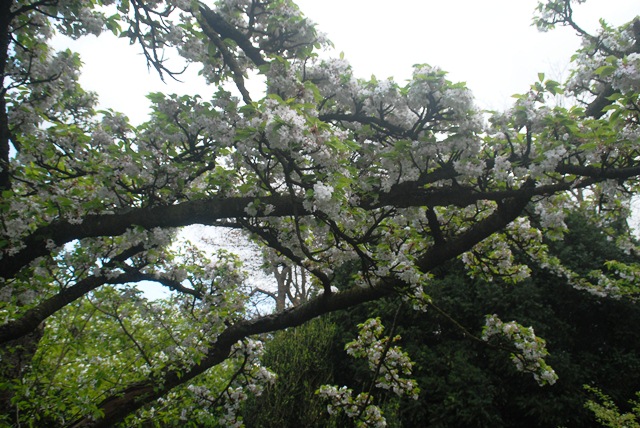 75km north of Brussels and about 25km north of Antwerp lies Kalmthout, a small town with 17.500 inhabitants. Its botanical garden was once said to be the best in Europe. 7000 varieties of plants grow in the extensive garden of 10ha and, surprisingly, more than 1 out of 3 plants is native to Japan. Invited by a Belgian friend, I visited this botanical garden the other day where Mr Abraham Rammeloo, the director of the garden, gave us a 2-hour guided tour around the garden premises. Although most of the cherry blossoms had already lost their petals, the flowers of the magnolias and rhododendrons were lovely and also the trees such as peach trees, maples, Japanese Judas trees (Katsura) and cypresses (Hinoki) have grown tall. This botanical garden opened in 1857, nearly 160 years ago. 75km north of Brussels and about 25km north of Antwerp lies Kalmthout, a small town with 17.500 inhabitants. Its botanical garden was once said to be the best in Europe. 7000 varieties of plants grow in the extensive garden of 10ha and, surprisingly, more than 1 out of 3 plants is native to Japan. Invited by a Belgian friend, I visited this botanical garden the other day where Mr Abraham Rammeloo, the director of the garden, gave us a 2-hour guided tour around the garden premises. Although most of the cherry blossoms had already lost their petals, the flowers of the magnolias and rhododendrons were lovely and also the trees such as peach trees, maples, Japanese Judas trees (Katsura) and cypresses (Hinoki) have grown tall. This botanical garden opened in 1857, nearly 160 years ago.
 Philipp Franz von Siebold, a physician in the first place, but also a botanist, returned home in 1828 after a 5-year stay in Japan. He brought back from Japan many plants, took up residence in Leiden in the Netherlands and introduced these plants throughout Europe. Part of these plants were sent to the botanical garden of Ghent, but were brought to Kalmthout’s botanical garden in the 1860s shortly after its opening. Nearly 100 years later, in 1954, Belgian botanist Ms Jelena de Belder bought the devastated garden and transplanted a whole variety of plants native to Japan that she had brought back from her several visits to Japan, turning the garden into a first-class botanical garden again. My Belgian friend who invited me is a son of Ms de Belder. He has a large garden himself at his house in Essen, not far from the botanical garden, where he also grows many plants that are also native to Japan. Philipp Franz von Siebold, a physician in the first place, but also a botanist, returned home in 1828 after a 5-year stay in Japan. He brought back from Japan many plants, took up residence in Leiden in the Netherlands and introduced these plants throughout Europe. Part of these plants were sent to the botanical garden of Ghent, but were brought to Kalmthout’s botanical garden in the 1860s shortly after its opening. Nearly 100 years later, in 1954, Belgian botanist Ms Jelena de Belder bought the devastated garden and transplanted a whole variety of plants native to Japan that she had brought back from her several visits to Japan, turning the garden into a first-class botanical garden again. My Belgian friend who invited me is a son of Ms de Belder. He has a large garden himself at his house in Essen, not far from the botanical garden, where he also grows many plants that are also native to Japan.
|

